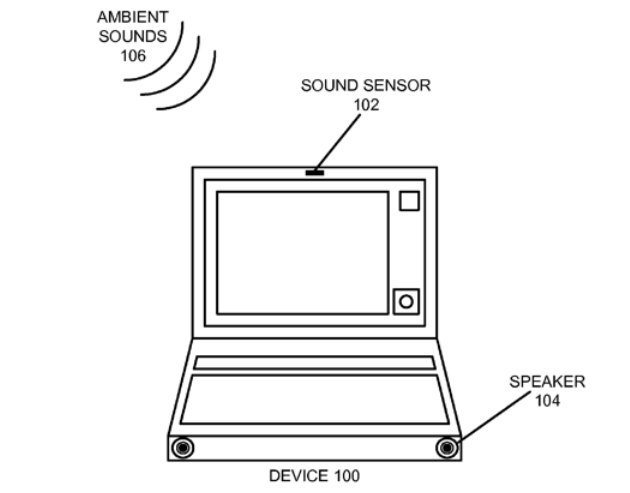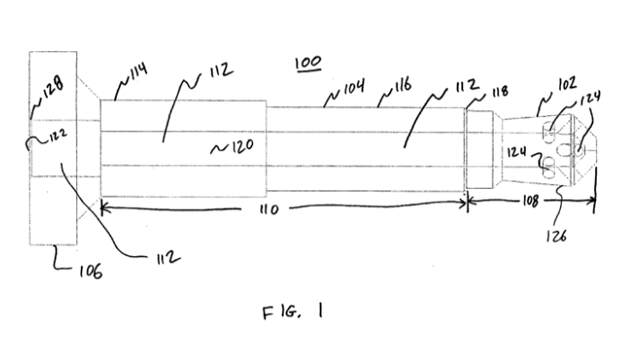Ambient Sound Sensor
In a patent filing published for the first time Thursday, the Cupertino-based electronics maker notes that devices such as televisions, computers, and mobile telephones are increasingly being used in a wide variety of environments for both business and entertainment purposes. However, as the devices become more widely used, their associated audio outputs may be more likely to disturb other people.
"For instance, a user who adjusts the volume of a mobile phone ring tone for a loud environment may later move to a quieter environment, where the loud ring will be disruptive," the filing explains. "Similarly, powering up a laptop computer in a quiet lecture hall or home may result in an inappropriately loud and disruptive boot sound. Alternatively, a volume level which is optimized for a quiet environment may not be detectable if the associated device is moved to a louder environment, which can result in a missed audio signal."
Therefore, Apple recommends that future electronics and iPhones employ a sound sensor to adjust their audio output to suit their current environment. During routine operation, the handset would call upon the built-in sound sensor to determine an ambient sound level for its surrounding environment. The iPhone could then adjusts its volume settings adaptively based on the determined ambient sound level, thereby avoiding a missed ringtone or toning down one that would otherwise be disruptive to other people in close proximity.
More specifically, the filing explains that the ambient sound level for an environment could be measured in a time interval during which the audio output of the device is minimized.
"For example, for a device playing music, the system may take samples from the sound sensor between songs, or between words in a song, to determine the ambient noise in a surrounding room,"Apple said. "If the system detects that the room is loud, it may raise the device output volume. Alternatively, if the room is quiet, the system may lower the device output volume."
Yet another approach to auto sound adjustment could see an electronic device account for its own role in the measured sound levels, for instance by subtracting its own audio output (when known) from the sound levels measured by the sound sensor.
In addition to iPhones and televisions, sound adjustment could be applied to a notebook computer prior to their boot sequence and audio chime. In this case, sound-processing circuitry would begin to estimate the ambient sound immediately upon power-on, the results of which would be quickly relayed to the operating system software.
Self-cleansing audio jacks
Separately, a second patent filing published Thursday essentially details methods of cleaning jacks in portable electronics that may have accumulated some debris from everyday use.
One method would be to design an adaptor plug with an internal hollow channel — an opening at the opposite end of the plug through which air can be applied — and a series of one or more openings at the plug end that are in communication with the hollow channel to provide a way for air applied to the hollow channel to exit the plug.
"A small hose or other conduit can be applied to the opening through which air or compressed air can be applied," Apple said. "In this manner, the opening may also include apparatus to temporarily secure the conduit to the adaptor plug, in order to minimize the amount of applied air that might otherwise leak out of the adaptor during the cleaning process. A consumer could place the adaptor plug in the jack, couple the conduit to the plug, and then apply compressed air through the conduit to clean the jack."
An alternative cleansing method would allow the end portion of the adaptor plug to rotate freely through the application of compressed air. This method, Apple said, would force debris from the jack as the adaptor plug is removed and the switches that hold the plug in the jack are closed.
 Sam Oliver
Sam Oliver


-m.jpg)






 Marko Zivkovic
Marko Zivkovic
 Mike Wuerthele
Mike Wuerthele
 Christine McKee
Christine McKee
 Amber Neely
Amber Neely
 Wesley Hilliard
Wesley Hilliard

 William Gallagher
William Gallagher










16 Comments
Yes, please!
day/night/in-cinema sensors... is latter feasible/
Hmm if they only had one of those new-fangled audio sensors in the unit already... Man, I've heard of these sorts of sensors before... Wait a second, they are called something like a mike-rah-fone. I think maybe there is already something like that on the phone.
There's also prior art for this in car stereos.
Rather than have a shit-storm of patents, how about giving us control over volume on the phone?! My instant message sound can cut steel, and it's not adjustable independent of the ringtone. It's not user editable either so I can't make new quieter ones.
This is an area where android is actually kicking the iPhones butt (there aren't many of them). c'mon apple give us better control over sound and notifications. Sheldon
I don't see how this is going to work if you keep your phone in a bag or even in a pocket. That could result in missed calls.
.....which would ameliorate potentially-disruptive audio outputs.
I haven't had my coffee yet.